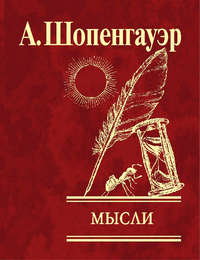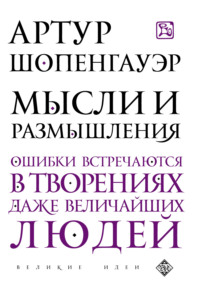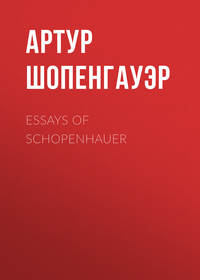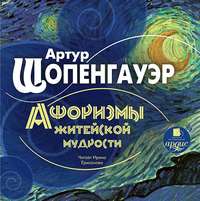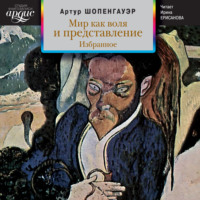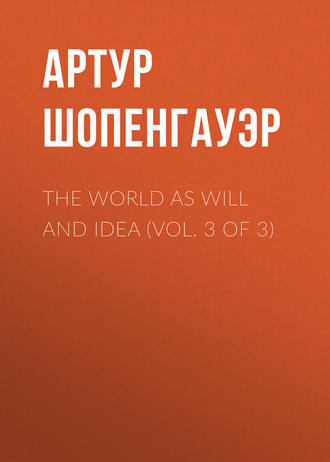 полная версия
полная версияThe World as Will and Idea (Vol. 3 of 3)
What reason is to the individual that is history to the human race. By virtue of reason, man is not, like the brute, limited to the narrow, perceptible present, but also knows the incomparably more extended past, with which it is linked, and out of which it has proceeded; and only thus has he a proper understanding of the present itself, and can even draw inferences as to the future. The brute, on the other hand, whose knowledge, devoid of reflection, is on this account limited to the present, even when it is tamed, moves about among men ignorant, dull, stupid, helpless, and dependent. Analogous to this is the nation that does not know its own history, is limited to the present of the now living generation, and therefore does not understand itself and its own present, because it cannot connect it with a past, and explain it from this; still less can it anticipate the future. Only through history does a nation become completely conscious of itself. Accordingly history is to be regarded as the rational consciousness of the human race, and is to the race what the reflected and connected consciousness is to the individual who is conditioned by reason, a consciousness through the want of which the brute is confined to the narrow, perceptible present. Therefore every gap in history is like a gap in the recollective self-consciousness of a man; and in the presence of a monument of ancient times which has outlived the knowledge of itself, as, for example, the Pyramids, or temples and palaces in Yucatan, we stand as senseless and stupid as the brute in the presence of the action of man, in which it is implicated in his service; or as a man before something written in an old cipher of his own, the key to which he has forgotten; nay, like a somnambulist who finds before him in the morning what he has done in his sleep. In this sense, then, history is to be regarded as the reason, or the reflected consciousness, of the human race, and takes the place of an immediate self-consciousness common to the whole race, so that only by virtue of it does the human race come to be a whole, come to be a humanity. This is the true value of history, and accordingly the universal and predominating interest in it depends principally upon the fact that it is a personal concern of the human race. Now, what language is for the reason of individuals, as an indispensable condition of its use, writing is for the reason of the whole race here pointed out; for only with this does its real existence begin, as that of the individual reason begins first with language. Writing serves to restore unity to the consciousness of the human race, which is constantly interrupted by death, and therefore fragmentary; so that the thought which has arisen in the ancestor is thought out by his remote descendant; it finds a remedy for the breaking up of the human race and its consciousness into an innumerable number of ephemeral individuals, and so bids defiance to the ever hurrying time, in whose hand goes forgetfulness. As an attempt to accomplish this we must regard not only written, but also stone monuments, which in part are older than the former. For who will believe that those who, at incalculable cost, set in action the human powers of many thousands for many years in order to construct the pyramids, monoliths, rock tombs, obelisks, temples, and palaces which have already existed for thousands of years, could have had in view the short span of their own life, too short to let them see the finishing of the construction, or even the ostensible end which the ignorance of the many required them to allege? Clearly their real end was to speak to their latest descendants, to put themselves in connection with these, and so to establish the unity of the consciousness of humanity. The buildings of the Hindus, the Egyptians, even the Greeks and Romans, were calculated to last several thousand years, because through higher culture their horizon was a wider one; while the buildings of the Middle Ages and of modern times have only been intended, at the most, to last a few centuries; which, however, is also due to the fact that men trusted more to writing after its use had become general, and still more since from its womb was born the art of printing. Yet even in the buildings of more recent times we see the desire to speak to posterity; and, therefore, it is shameful if they are destroyed or disfigured in order to serve low utilitarian ends. Written monuments have less to fear from the elements, but more to fear from barbarians, than stone ones; they accomplish far more. The Egyptians wished to combine the two, for they covered their stone monuments with hieroglyphics, nay, they added paintings in case the hieroglyphics should no longer be understood.
Chapter XXXIX.25 On The Metaphysics Of Music
The outcome, or result, of my exposition of the peculiar significance of this wonderful art, which is given in the passage of the first volume referred to below, and which will here be present to the mind of the reader, was, that there is indeed no resemblance between its productions and the world as idea, i. e., the world of nature, but yet there must be a distinct parallelism, which was then also proved. I have yet to add some fuller particulars with regard to this parallelism, which are worthy of attention.
The four voices, or parts, of all harmony, the bass, the tenor, the alto, and the soprana, or the fundamental note, the third, the fifth, and the octave, correspond to the four grades in the series of existences, the mineral kingdom, the vegetable kingdom, the brute kingdom, and man. This receives an additional and striking confirmation in the fundamental rule of music, that the bass must be at a much greater distance below the three upper parts than they have between themselves; so that it must never approach nearer to them than at the most within an octave of them, and generally remains still further below them. Hence, then, the correct triad has its place in the third octave from the fundamental note. Accordingly the effect of extended harmony, in which the bass is widely separated from the other parts, is much more powerful and beautiful than that of close harmony, in which it is moved up nearer to them, and which is only introduced on account of the limited compass of the instruments. This whole rule, however, is by no means arbitrary, but has its root in the natural source of the tonal system; for the nearest consonant intervals that sound along with the fundamental note by means of its vibrations are the octave and its fifth. Now, in this rule we recognise the analogue of the fundamental characteristic of nature on account of which organised beings are much more nearly related to each other than to the inanimate, unorganised mass of the mineral kingdom, between which and them exists the most definite boundary and the widest gulf in the whole of nature. The fact that the high voice which sings the melody is yet also an integral part of the harmony, and therein accords even with the deepest fundamental bass, may be regarded as the analogue of the fact that the same matter which in a human organism is the supporter of the Idea of man must yet also exhibit and support the Ideas of gravitation and chemical qualities, that is, of the lowest grades of the objectification of will.
That music acts directly upon the will, i. e., the feelings, passions, and emotions of the hearer, so that it quickly raises them or changes them, may be explained from the fact that, unlike all the other arts, it does not express the Ideas, or grades of the objectification of the will, but directly the will itself.
As surely as music, far from being a mere accessory of poetry, is an independent art, nay, the most powerful of all the arts, and therefore attains its ends entirely with means of its own, so surely does it not stand in need of the words of the song or the action of an opera. Music as such knows the tones or notes alone, but not the causes which produce these. Accordingly, for it even the human voice is originally and essentially nothing else than a modified tone, just like that of an instrument; and, like every other tone, it has the special advantages and disadvantages which are a consequence of the instrument that produces it. Now, in this case, that this same instrument, as the organ of speech, also serves to communicate conceptions is an accidental circumstance, which music can certainly also make use of, in order to enter into a connection with poetry; but it must never make this the principal matter, and concern itself entirely with the expression of what for the most part, nay (as Diderot gives us to understand in Le Neveu de Rameau), essentially are insipid verses. The words are and remain for the music a foreign addition, of subordinate value, for the effect of the tones is incomparably more powerful, more infallible, and quicker than that of the words. Therefore, if words become incorporated in music, they must yet assume an entirely subordinate position, and adapt themselves completely to it. But the relation appears reversed in the case of the given poetry, thus the song or the libretto of an opera to which music is adapted. For the art of music at once shows in these its power and higher fitness, disclosing the most profound ultimate and secret significance of the feeling expressed in the words or the action presented in the opera, giving utterance to their peculiar and true nature, and teaching us the inmost soul of the actions and events whose mere clothing and body is set before us on the stage. With regard to this superiority of the music, and also because it stands to the libretto and the action in the relation of the universal to the particular, of the rule to the example, it might perhaps appear more fitting that the libretto should be written for the music than that the music should be composed for the libretto. However, in the customary method, the words and actions of the libretto lead the composer to the affections of the will which lie at their foundation, and call up in him the feelings to be expressed; they act, therefore, as a means of exciting his musical imagination. Moreover, that the addition of poetry to music is so welcome to us, and a song with intelligible words gives us such deep satisfaction, depends upon the fact that in this way our most direct and most indirect ways of knowing are called into play at once and in connection. The most direct is that for which music expresses the emotions of the will itself, and the most indirect that of conceptions denoted by words. When the language of the feelings is in question the reason does not willingly sit entirely idle. Music is certainly able with the means at its own disposal to express every movement of the will, every feeling; but by the addition of words we receive besides this the objects of these feelings, the motives which occasion them. The music of an opera, as it is presented in the score, has a completely independent, separate, and, as it were, abstract existence for itself, to which the incidents and persons of the piece are foreign, and which follows its own unchanging rules; therefore it can produce its full effect without the libretto. But this music, since it was composed with reference to the drama, is, as it were, the soul of the latter; for, in its connection with the incidents, persons, and words, it becomes the expression of the inner significance of all those incidents, and of their ultimate and secret necessity which depends upon this significance. The pleasure of the spectator, unless he is a mere gaper, really depends upon an indistinct feeling of this. Yet in the opera music also shows its heterogeneous nature and higher reality by its entire indifference to the whole material of the incidents; in consequence of which it everywhere expresses the storm of the passions and the pathos of the feelings in the same way, and its tones accompany the piece with the same pomp, whether Agamemnon and Achilles or the dissensions of a bourgeois family form its material. For only the passions, the movements of the will, exist for it, and, like God, it sees only the hearts. It never assimilates itself to the natural; and therefore, even when it accompanies the most ludicrous and extravagant farces of the comic opera, it still preserves its essential beauty, purity, and sublimity; and its fusion with these incidents is unable to draw it down from its height, to which all absurdity is really foreign. Thus the profound and serious significance of our existence hangs over the farce and the endless miseries of human life, and never leaves it for a moment.
If we now cast a glance at purely instrumental music, a symphony of Beethoven presents to us the greatest confusion, which yet has the most perfect order at its foundation, the most vehement conflict, which is transformed the next moment into the most beautiful concord. It is rerum concordia discors, a true and perfect picture of the nature of the world which rolls on in the boundless maze of innumerable forms, and through constant destruction supports itself. But in this symphony all human passions and emotions also find utterance; joy, sorrow, love, hatred, terror, hope, &c., in innumerable degrees, yet all, as it were, only in abstracto, and without any particularisation; it is their mere form without the substance, like a spirit world without matter. Certainly we have a tendency to realise them while we listen, to clothe them in imagination with flesh and bones, and to see in them scenes of life and nature on every hand. Yet, taken generally, this is not required for their comprehension or enjoyment, but rather imparts to them a foreign and arbitrary addition: therefore it is better to apprehend them in their immediacy and purity.
Since now, in the foregoing remarks, and also in the text, I have considered music only from the metaphysical side, that is, with reference to the inner significance of its performances, it is right that I should now also subject to a general consideration the means by which, acting upon our mind, it brings these about; therefore that I should show the connection of that metaphysical side of music, and the physical side, which has been fully investigated, and is well known, I start from the theory which is generally known, and has by no means been shaken by recent objections, that all harmony of the notes depends upon the coincidence of their vibrations, which when two notes sound together occurs perhaps at every second, or at every third, or at every fourth vibration, according to which, then, they are the octave, the fifth, or the fourth of each other, and so on. So long as the vibrations of two notes have a rational relation to each other, which can be expressed in small numbers, they can be connected together in our apprehension through their constantly recurring coincidence: the notes become blended, and are thereby in consonance. If, on the other hand, that relation is an irrational one, or one which can only be expressed in larger numbers, then no coincidence of the vibrations which can be apprehended occurs, but obstrepunt sibi perpetuo, whereby they resist being joined together in our apprehension, and accordingly are called a dissonance. Now, according to this theory, music is a means of making rational and irrational relations of numbers comprehensible, not like arithmetic by the help of the concept, but by bringing them to a knowledge which is perfectly directly and simultaneously sensible. Now the connection of the metaphysical significance of music with this its physical and arithmetical basis depends upon the fact that what resists our apprehension, the irrational relation, or the dissonance, becomes the natural type of what resists our will; and, conversely, the consonance, or the rational relation, which easily adapts itself to our apprehension, becomes the type of the satisfaction of the will. And further, since that rational and irrational element in the numerical relations of the vibrations admits of innumerable degrees, shades of difference, sequences, and variations, by means of it music becomes the material in which all the movements of the human heart, i. e., of the will, movements whose essential nature is always satisfaction and dissatisfaction, although in innumerable degrees, can be faithfully portrayed and rendered in all their finest shades and modifications, which takes place by means of the invention of the melody. Thus we see here the movements of the will transferred to the province of the mere idea, which is the exclusive scene of the achievements of the fine arts, for they absolutely demand that the will itself shall not interfere, and that we shall conduct ourselves as pure knowing subjects. Therefore the affections of the will itself, thus actual pain and actual pleasure, must not be excited, but only their substitutes, that which is agreeable to the intellect, as a picture of the satisfaction of the will, and that which is more or less repugnant to it, as a picture of greater or less pain. Only thus does music never cause us actual sorrow, but even in its most melancholy strains is still pleasing, and we gladly hear in its language the secret history of our will, and all its emotions and strivings, with their manifold protractions, hindrances, and griefs, even in the saddest melodies. When, on the other hand, in reality and its terrors, it is our will itself that is roused and tormented, we have not then to do with tones and their numerical relations, but are rather now ourselves the trembling string that is stretched and twanged.
But, further, because, in consequence of the physical theory which lies at its foundation, the musical quality of the notes is in the proportion of the rapidity of their vibrations, but not in their relative strength, the musical ear always follows by preference, in harmony, the highest note, not the loudest. Therefore, even in the case of the most powerful orchestral accompaniment, the soprano comes out clearly, and thus receives a natural right to deliver the melody. And this is also supported by its great flexibility, which depends upon the same rapidity of the vibrations, and shows itself in the ornate passages, whereby the soprano becomes the suitable representative of the heightened sensibility, susceptible to the slightest impression, and determinable by it, consequently of the most highly developed consciousness standing on the uppermost stage of the scale of being. Its opposite, from converse causes, is the bass, inflexible, rising and falling only in great intervals, thirds, fourths, and fifths, and also at every step guided by rigid rules. It is therefore the natural representative of the inorganic kingdom of nature, which is insensible, insusceptible to fine impressions, and only determinable according to general laws. It must indeed never rise by one tone, for example, from a fourth to a fifth, for this produces in the upper parts the incorrect consecutive fifths and octaves; therefore, originally and in its own nature, it can never present the melody. If, however, the melody is assigned to it, this happens by means of counterpoint, i. e., it is an inverted bass – one of the upper parts is lowered and disguised as a bass; properly speaking, it then requires a second fundamental bass as its accompaniment. This unnaturalness of a melody lying in the bass is the reason why bass airs, with full accompaniment, never afford us pure, undisturbed pleasure, like the soprano air, which, in the connection of harmony, is alone natural. We may remark in passing that such a melodious bass, forcibly obtained by inversion, might, in keeping with our metaphysic of music, be compared to a block of marble to which the human form has been imparted: and therefore it is wonderfully suitable to the stone guest in “Don Juan.”
But now we shall try to get somewhat nearer the foundation of the genesis of melody, which can be accomplished by analysing it into its constituent parts, and in any case will afford us the pleasure which arises from bringing to abstract and distinct consciousness what every one knows in the concrete, so that it gains the appearance of novelty.
Melody consists of two elements, the one rhythmical, the other harmonious. The former may also be described as the quantitative, the latter as the qualitative element, since the first is concerned with the duration, and the second with the pitch of the notes. In the writing of music the former depends upon the perpendicular, and the latter upon the horizontal lines. Purely arithmetical relations, thus relations of time, lie at the foundation of both; in the one case the relative duration of the notes, in the other the relative rapidity of their vibrations. The rhythmical element is the essential; for it can produce a kind of melody of itself alone, and without the other, as, for example, on the drum; yet complete melody requires both elements. It consists in an alternating disunion and reconciliation of them, as I shall show immediately; but first, since I have already spoken of the harmonious element in what has been said, I wish to consider the rhythmical element somewhat more closely.
Rhythm is in time what symmetry is in space, division into equal parts corresponding to each other. First, into larger parts, which again fall into smaller parts, subordinate to the former. In the series of the arts given by me architecture and music are the two extreme ends. Moreover, according to their inner nature, their power, the extent of their spheres, and their significance, they are the most heterogeneous, indeed true antipodes. This opposition extends even to the form of their appearance, for architecture is in space alone, without any connection with time; and music is in time alone, without any connection with space.26 Now hence springs their one point of analogy, that as in architecture that which orders and holds together is symmetry, in music it is rhythm, and thus here also it holds true that extremes meet. As the ultimate constituent parts of a building are the exactly similar stones, so the ultimate constituent parts of a musical composition are the exactly similar beats; yet by being weak or strong, or in general by the measure, which denotes the species of time, these are divided into equal parts, which may be compared to the dimensions of the stone. The musical period consists of several bars, and it has also two equal parts, one rising, aspiring, generally going to the dominant, and one sinking, quieting, returning to the fundamental note. Two or several periods constitute a part, which in general is also symmetrically doubled by the sign of repetition; two parts make a small piece of music, or only a movement of a larger piece; and thus a concerto or sonata usually consists of three movements, a symphony of four, and a mass of five. Thus we see the musical composition bound together and rounded off as a whole, by symmetrical distribution and repeated division, down to the beats and their fractions, with thorough subordination, superordination, and co-ordination of its members, just as a building is connected and rounded off by its symmetry. Only in the latter that is exclusively in space which in the former is exclusively in time. The mere feeling of this analogy has in the last thirty years called forth the oft-repeated, daring witticism, that architecture is frozen music. The origin of this can be traced to Goethe; for, according to Eckermann's “Conversations,” vol. ii. p. 88, he said: “I have found among my papers a page on which I call architecture a rigidified music; and really there is something in it; the mood which is produced by architecture approaches the effect of music.” Probably he let fall this witticism much earlier in conversation, and in that case it is well known that there were never wanting persons to pick up what he so let fall that they might afterwards go about decked with it. For the rest, whatever Goethe may have said, the analogy of music and architecture, which is here referred by me to its sole ground, the analogy of rhythm with symmetry, extends accordingly only to the outward form, and by no means to the inner nature of the two arts, which is entirely different. Indeed it would be absurd to wish to put on the same level in essential respects the most limited and the weakest of all the arts, and the most far-reaching and powerful. As an amplification of the analogy pointed out, we might add further, that when music, as it were in a fit of desire for independence, seizes the opportunity of a pause to free itself from the control of rhythm, to launch out into the free imagination of an ornate cadenza, such a piece of music divested of all rhythm is analogous to the ruin which is divested of symmetry, and which accordingly may be called, in the bold language of the witticism, a frozen cadenza.




